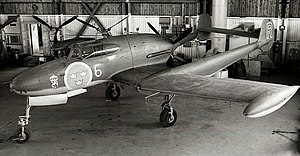| SAAB 21 | |
|---|---|
 | |
| General information | |
| Type | Fighter and attack aircraft |
| National origin | Sweden |
| Manufacturer | SAAB |
| Status | Retired |
| Primary user | Swedish Air Force |
| Number built | 298 |
| History | |
| Manufactured | 1945–1949 |
| Introduction date | 1 December 1945 |
| First flight | 30 July 1943 |
| Retired | 23 July 1954 |
| Developed into | SAAB 21R |
The SAAB 21 is a Swedish single-seat low-wing monoplane fighter and attack aircraft designed and manufactured by SAAB. It used a twin boom fuselage with a pusher engine, giving the aircraft an unusual appearance.
Work began at SAAB following a Swedish Air Force decision to embark on a major expansion programme in preparation for the possibility of being drawn into the Second World War. The company designed a monoplane twin-boom aircraft, powered by a single Daimler-Benz DB 605B engine that was positioned to the rear of the fuselage nacelle, directly behind the pilot, and drove a pusher propeller. This arrangement allowed guns to be carried in the aircraft's nose while providing the pilot with good visibility. To enable the pilot to bail out without hitting the propeller behind him, they adopted an ejection seat.
On 30 July 1943, the 21 performed its maiden flight and on 1 December 1945, the first examples of the J 21A-1 were introduced to service. It was quickly followed by the improved J 21A-2, which featured heavier armament, and the A 21A-3 fighter-bomber.
With jet-powered aircraft rapidly overtaking 'traditional' piston-powered aircraft, in 1947 SAAB produced a conversion of the 21 using the British de Havilland Goblin jet engine, the resulting airframe being designated the SAAB 21R. Along with the Soviet Yakovlev Yak-3, the SAAB 21 was one of only two jet fighters to be successfully converted from piston-power to jet-power.[1]
The 21 was replaced in the mid-1950s after less than 10 years of service by the similarly configured de Havilland Vampire and the Saab 29 Tunnan.
- ^ Gunston 1995, p. 472.